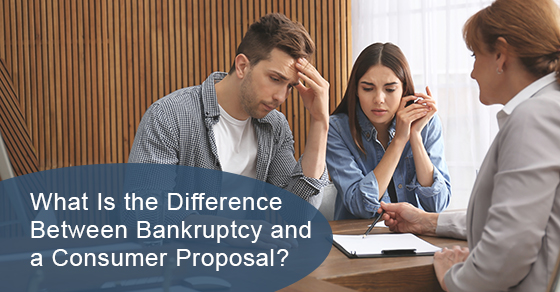Filing for bankruptcy or a consumer proposal are both viable forms of debt relief. Still, how do they differ from each other? While they both provide legal protection from creditors and function similarly in terms of outcomes, there are many essential differences between them. Understanding your debt relief options will come in very handy when dealing with debt-fuelled stress and anxiety.
Want to learn how you can utilize consumer proposals and bankruptcy filings to become debt-free? Keep reading for the key differences between the two.
What is a consumer proposal?
A consumer proposal is a formal agreement that is filed between you and your various creditors. It is created with the help of a licensed insolvency trustee, who will help you with debt alleviation and repayment strategies. The contract will typically entail paying part or all of your debt over a set period of time.
Consumer proposals come in handy because they help you to reduce your debt in a controlled and manageable way. You’ll also be safe from elements like debt collectors, legal ramifications, and wage garnishments. Interest charges on your credit cards will stop accumulating when you file a consumer proposal.
What is bankruptcy?
On the other hand, bankruptcy is a legal process that can potentially relieve you of all the debts you owe. Again, a licensed insolvency trustee is required to investigate your claim to analyze your finances and monitor your case proceedings. You will typically have bankruptcy duties to carry out when you file. This can include attending credit counseling sessions (usually two sessions per case), and filing monthly income and expense reports. After all the proceedings are completed you, in your first filing, can be relieved from your debt between nine and 21 months.
What are the major differences between the two?
The primary differences between the two debt relief options is asset consequences. In bankruptcy filings, you usually surrender any non-exempt and relevant assets to eliminate your debts as much as possible. With consumer proposals, you’re paying back a portion of your debts. As such, you retain your assets but they are considered in the amount you offer your creditors.
Consumer proposals are applicable on a maximum of $250,000 in unsecured debt (there are a separate type of proposals in the case of higher debt). This excludes your mortgage on your principal residence. Bankruptcy is relevant to a minimum of $1,000 in unsecured debt.
They also differ in settlement or repayment plans. Consumer proposals have a negotiated repayment amount, which is split into monthly payments and to which the majority of creditors must agree. Bankruptcy requires monthly payments, which are decided based on monthly gross income. Consumer proposals can go on for up to five years, while bankruptcies typically last between nine and 21 months.
What do the two have in common?
The primary commonality is that both options protect you from legal ramifications and creditors. You’ll stop receiving collection calls, which can be a significant relief. Your interest charges will also freeze if you go with one of the two options. In both cases, you’ll have the support of a licensed insolvency trustee, as both bankruptcy and consumer proposals fall under the Bankruptcy and Insolvency Act of Canada.
Most importantly, both choices will help you with your financial recovery! With these options, not only will you be well on your way to healthy finances, but you’ll also receive financial education, which is a life skill that’s worth learning.
Which option is right for me?
A consumer proposal has fewer short-term consequences, comparatively. It can be beneficial to both you and your creditors if your financial situation is solid and can support consistent repayment for a term. As well, you’ll benefit from affordable payment schedules while holding on to your assets.
However, there are times when filing for bankruptcy is a better choice. If you’re dealing with a sudden loss of income after getting laid off, for example, bankruptcy might be a better option. It is easier to approve (compared to a proposal), and it offers a quick solution. Bankruptcy also has no debt limit; any amount upwards of $1000 can be filed for.
Bankruptcy generally takes less time than a consumer proposal. If you can’t afford to pay back your debt, then bankruptcy would be a better option, as you won’t need to follow the requirements of a bankruptcy. You may need to give up some of your assets, but the good news is that you won’t lose everything. You’ll be exempted from giving up food, clothing, appliances, furniture, pensions, certain life insurance and RRSP’s, and even your car!
At the end of the day, the option you choose will depend entirely on your financial situation. Both are viable and effective forms of debt relief. However, considering that this decision will have long and short-term impacts on your economic history, it’s better to do your research and arrive at a solution that will work for your needs.
Navigating the world of debt consolidation or elimination can be challenging. You’ve likely felt stressed out, confused, and even anxious throughout the process. Lucky for you, our team at Kevin Thatcher & Associates is here to put your mind at ease. We have helped thousands of people solve their money problems, and we can help you too, no matter your situation. Be sure to reach out to our team for more information today!
To learn more about consumer proposals, call Kevin Thatcher & Associates at 1-888-702-9801 or contact us here.

